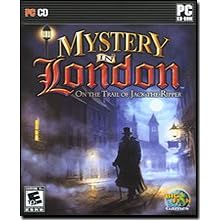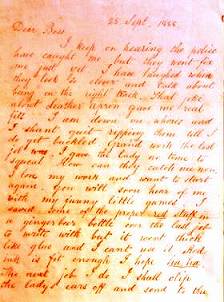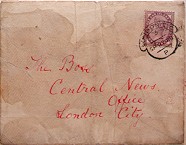ArnPriorEMC
Click to Enlarge

Jeffrey Maguire, Arnprior EMC
A visit to the Sherlock Holmes Public House and Restaurant on Northumberland Street in London, England is an absolute must for any fan of the famous, fictional consulting detective. The main floor pub is filled with Holmes' memorabilia. The first floor (second storey) restaurant features starters and main courses named for Sherlock Holmes' well known cases, the work of author Sir Arthur Conan Doyle.
EDITOR'S NOTE: This is the latest in an ongoing series of travel articles by EMC feature writer Jeff Maguire. He and his wife Kathleen, who live in Carleton Place, have traveled extensively in the United Kingdom, Ireland and Continental Europe for 15 years. North American destinations, including Ottawa Valley and eastern Ontario day trips, will feature from time to time.
Perhaps the ultimate compliment an author can receive is when their fictional character is believed to be a real person. There aren't very many examples in literature, but one that immediately comes to my mind is the creation of Scottish novelist and physician Sir Arthur Conan Doyle (1859-1930).
Sherlock Holmes, the "brilliant" London-based consulting detective, is of course the main character in four novels and more than 50 short stories written by Doyle. Pure fiction - but talk about a character that has come to life!
To this day many visitors to London ask staff at the Park Plaza Sherlock Holmes Hotel which direction they should walk "to see Sherlock Holmes house" on Baker Street.
Thanks to author Doyle and his writing, and the countless films and television shows which spun from his work, 221B Baker Street is the most famous address in the British capital, if not the world!
Of course the front desk people at the hotel (it is located at 108 Baker St.), or tourist information staff anywhere in London, can easily direct people to 221B. There is such an address. At present it is the home of the Sherlock Holmes Museum, although it wasn't always thus.
Unfortunately they can only smile and shake their heads when asked for directions to "where he (Holmes) is buried" which, believe it or not, is an oft-asked query to this day.
Credit Conan Doyle of course! Kudos also to the film producers and actors who have helped turn Holmes into such a "real" figure.
You can find a statue of Sherlock Holmes in Central London. At nine feet in height the bronze sculpture is, like the "man" himself, larger than life.
Family and friends who are aware of my love for London are responsible for this article actually. Knowing my personal interest in the great detective they suggested I take readers on a tour of "Sherlock Holmes London." Places my wife and I are very familiar with.
New film
It was the release of the latest Hollywood film on the ingenious sleuth, simply titled 'Sherlock Holmes', which finally prompted me to write this. The movie, which stars Robert Downey Jr. as Holmes and Jude Law as his faithful friend and companion Dr. John Watson, hit theatres at Christmas. It has been very successful too!
Despite being interested in the film I won't rush out to see it. Downey Jr., who is a good actor, isn't my vision of Holmes. And certainly Law doesn't appeal to me in the Watson role.
I'm told the latest movie is based more on action - lots of fighting and gadgetry - rather than Holmes' famous powers of deduction.
Of course with more than 200 movies and television shows featuring Sherlock Holmes already circulating, it would be difficult to make another formula film today and attract an audience. The current movie is aimed at a younger audience, whereas most fans of the genre are older people.
Who is my favorite Sherlock Holmes of all time you ask?
There are three actually. I will take Basil Rathbone (and his sidekick Nigel Bruce as Watson) any day of the week. Especially their version of 'Hound of the Baskervilles' (1939).
Forty years later Canadian-born Christopher Plummer turned in a solid performance as Holmes in 'Murder by Decree' (1979) which also featured the late, great British actor James Mason as Dr. Watson.
My all-time favourite Holmes has to be the late Jeremy Brett who portrayed the detective in 'The Adventures of Sherlock Holmes' which aired in 41 television episodes between 1984 and 1994. Never mind the series was actually filmed at Granada Studios in Manchester, northwest England. To me Brett is the consummate Sherlock Holmes.
But back to the Holmes statue!
It stands on Marylebone Road in front of the main entrance to Baker Street Underground Station and close to famous Madame Tussaud's wax museum and the adjoining London Planetarium. Madame Tussaud's, I am told, currently features a wax figure of actor Downey Jr. as Holmes.
The statue, which depicts the famous character wearing his traditional deerstalker hat and holding his pipe is the creation of English sculptor John Doubleday. It was unveiled in 1999 after a seven decade campaign to have such a statue erected in London.
In one of the Holmes' stories or movies (I'm not sure which) the detective tells Watson (I am paraphrasing here) "Having a complete knowledge of London is a hobby of mine."
I can hardly profess to have Holmes' incredible wealth of knowledge.
But to me there is no better place to start Part 1 of this relatively short written tour of Sherlock Holmes' London, than at the statue.
A few paces to the west is Baker St. A right turn and a short walk and soon, on the opposite side (west side) of the street is what was once 221B. Just like there was no Sherlock Holmes there was no house with that street number either.
But for novelty's sake the former Abbey National Building Society once answered the huge amount of mail addressed to Sherlock Holmes at 221B.
However, a long-running dispute developed between the society and the Sherlock Holmes Museum, located on the same side of the street but farther to the north and Westminster City Council. Baker St. is within the City of Westminster a major section of Central London.
The number was assigned to the museum when it first opened in 1990 but hadn't been included in the original planning consent for the facility. That opened the door to trouble!
The saga is too long and complicated to relate. During the time the Holmes' stories were set, numbers on Baker St. only went as high as 100. So it's a mute point in some ways.
MUSEUM VISIT
The current museum, at 237-241 Baker St., bears the same blue plaque unveiled in 1990, with "221-B" engraved on it. It's easily the most popular of numerous blue historic plaques across London.
After Abbey (later Abbey National plc and now Santander) left its Baker St. building in 2005, the Royal Mail (national post office) officially recognized the museum's exclusive right to receive mail addressed to Sherlock Holmes.
I asked an employee at the museum and was told they have a full-time staff member who answers the 50-100 letters per week (yes, up to 100 a week) addressed to the detective. Incredible!
The museum on the first and second floors (second and third stories to Canadians) is well worth a tour. It is filled with items mentioned in the stories - very Victorian and authentic looking. You will see Holmes' study and Watson's bedroom. There are even 17 steps leading to the first floor, just as Conan Doyle's books outline.
The main floor shop has a huge selection of items, most of which are over priced in my opinion. But hey, this is London after all!
It is a short walk from the museum to nearby Regent's Park which, in my opinion, is one of the nicest green spaces in the very green capital. Queen Mary's Rose Garden, which is filled with fragrant flowers at the height of the season, is a particular favourite of my wife's.
If you visit or stay at the aforementioned Park Plaza Sherlock Holmes, which is south along Baker St., apparently it has quite a bit of Holmes memorabilia in its aptly named "Sherlock's Bar" and in its main restaurant - "Sherlock's Grill" of course. Acquaintances tell us it is a good place to stay although we never have.
Not surprisingly many businesses along Baker St. have tied themselves to the Holmes legend and souvenirs can be found in numerous locations in the immediate area. Follow Paddington St. and you will find 'Sherlock Mews'. The mews are where the horses were kept. In modern London many have been turned into exclusive and expensive addresses. The entire Marylebone area is quite well heeled actually!
Unfortunately many buildings on Baker St. and its environs were obliterated during 'The Blitz' in World War II. That has taken away from the previous Victorian look of the street, with modern construction replacing the old.
Back in Baker St. tube station, if you take the Jubilee line you will encounter murals on the platform walls which illustrate the Holmes' stories.
To begin Part 2 of our tour, the Bakerloo line is the best choice. You'll be whisked all the way to Embankment Station which, as the name suggests, is close to the north bank of the River Thames.
Walking tour
Every Friday a London Walks tour guide meets customers at the main entrance to Embankment Station, as the south end of Villiers St. At 2 o'clock you can embark on a comprehensive walking tour which is well worth the price.
For anyone who may have read my earlier piece in this series on the Jack the Ripper tour, it is the same company. But in contrast to the real life Ripper tale, which captivates so many right to this day, Sherlock Holmes - well, he can't hold a candle to 'Jack' I'm afraid.
The Holmes' tour is one afternoon a week. By contrast the Jack the Ripper walk leaves Tower Hill Station at 7:30, 363 days a year (Christmas Eve and Christmas Day excepted).
Sorry Sherlock!
Still, Holmes' fans will love this tour which takes in so many locations from Conan Doyle's books, the places favoured by the detective.
Walk north on Villiers St. and you soon come to Charing Cross Station which seems to pop up in so many Holmes' stories, films and TV shows.
The author picked many of his own favourite locations as settings for his fictional book character. Charing Cross Station fronts onto The Strand, one of the busiest and most famous streets in Central London.
It was here that Holmes enjoyed roast beef at his favourite restaurant 'Simpson's-in-the-Strand' which is very real and extremely popular to this day.
Also on The Strand is the Lyceum Theatre which features in at least one story. In nearby Covent Garden, the former fruit and vegetable market of London, stands the famous Royal Opera House which is prominent in so many of the Holmes' stories and films.
Close to the opera is Freemasons Hall, the home of Freemasonry. Threads of the world's oldest secular fraternal society run through both the fictional Sherlock Holmes tales and the real-life Jack the Ripper mystery.
Nearby, to the west and north, although not necessarily on the official tours (there is more than one of course), are such famous squares as Trafalgar and Leicester. And what Sherlock Holmes tour would be complete without a stroll through Piccadilly Circus where Holmes was attacked in a restaurant in one of the famous tales.
For our money the best possible place to end any tour is at the pub and restaurant named for the famous man. Kathy and I have visited 'The Sherlock Holmes Public House and Restaurant' on every one of our many visits to London. In fact a visit to London wouldn't be complete without more than one visit to a pub which is no so familiar to us.
'The Holmes' is located at 10-11 Northumberland St., Westminster, not far from Charing Cross Station and Trafalgar Square. It is often crowded - the sign of a good establishment - and the beer is plentiful and well kept (sample the Sherlock Holmes Ale).
The pub is filled with Holmes' memorabilia and TV sets in the corners constantly play films about the famous detective. You can also purchase souvenirs.
The pub menu is traditional but good (the ploughman's lunch is excellent) although if you want something extra special, book a table at the upstairs restaurant as we have several times. On the way upstairs you can see a reproduction of Sherlock Holmes' study at 221B Baker St. complete with a lifelike wax figure of the detective.
The upstairs menu features starters and main courses named for Holmes' cases including 'The Copper Beeches' and 'Hound of the Baskervilles'.
Fans of Sherlock Holmes will love everything about the British capital. The two are forever intertwined. Following the trail of Sherlock Holmes is another of the quintessential experiences in fascinating London.
HOW TO GET THERE: If you visit London and wish to take the self guided or professionally led walking tours I have mentioned, the best way to reach either location is via the vast Underground network. Baker St. is easy to locate by traveling to the tube station of the same name. Baker Street Tube is accessible via the Circle, Hammersmith and City, Metropolitan, Bakerloo and Jubilee lines. Embankment Station, where the Friday afternoon 'London Walks' tour begins is also a major location on the network. It's accessible via the District, Circle, Bakerloo and Northern lines.











